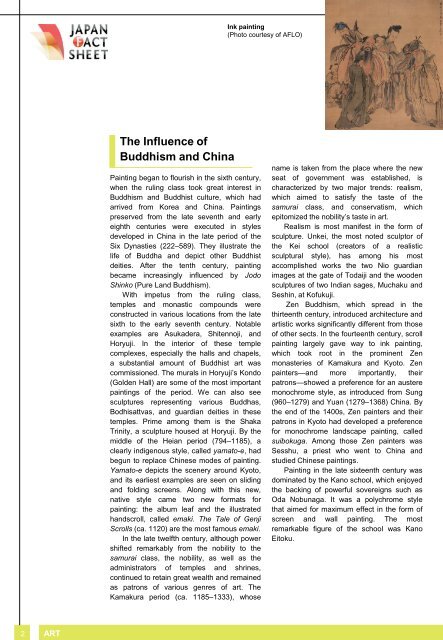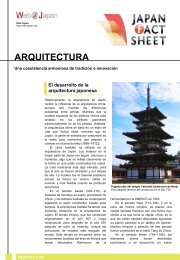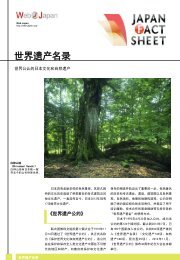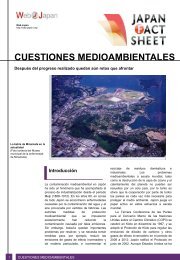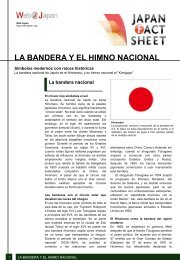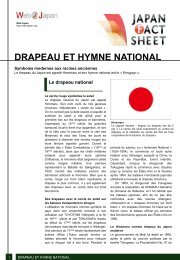Art - Web Japan
Art - Web Japan
Art - Web Japan
Create successful ePaper yourself
Turn your PDF publications into a flip-book with our unique Google optimized e-Paper software.
Ink painting<br />
(Photo courtesy of AFLO)<br />
The Influence of<br />
Buddhism and China<br />
Painting began to flourish in the sixth century,<br />
when the ruling class took great interest in<br />
Buddhism and Buddhist culture, which had<br />
arrived from Korea and China. Paintings<br />
preserved from the late seventh and early<br />
eighth centuries were executed in styles<br />
developed in China in the late period of the<br />
Six Dynasties (222–589). They illustrate the<br />
life of Buddha and depict other Buddhist<br />
deities. After the tenth century, painting<br />
became increasingly influenced by Jodo<br />
Shinko (Pure Land Buddhism).<br />
With impetus from the ruling class,<br />
temples and monastic compounds were<br />
constructed in various locations from the late<br />
sixth to the early seventh century. Notable<br />
examples are Asukadera, Shitennoji, and<br />
Horyuji. In the interior of these temple<br />
complexes, especially the halls and chapels,<br />
a substantial amount of Buddhist art was<br />
commissioned. The murals in Horyuji’s Kondo<br />
(Golden Hall) are some of the most important<br />
paintings of the period. We can also see<br />
sculptures representing various Buddhas,<br />
Bodhisattvas, and guardian deities in these<br />
temples. Prime among them is the Shaka<br />
Trinity, a sculpture housed at Horyuji. By the<br />
middle of the Heian period (794–1185), a<br />
clearly indigenous style, called yamato-e, had<br />
begun to replace Chinese modes of painting.<br />
Yamato-e depicts the scenery around Kyoto,<br />
and its earliest examples are seen on sliding<br />
and folding screens. Along with this new,<br />
native style came two new formats for<br />
painting: the album leaf and the illustrated<br />
handscroll, called emaki. The Tale of Genji<br />
Scrolls (ca. 1120) are the most famous emaki.<br />
In the late twelfth century, although power<br />
shifted remarkably from the nobility to the<br />
samurai class, the nobility, as well as the<br />
administrators of temples and shrines,<br />
continued to retain great wealth and remained<br />
as patrons of various genres of art. The<br />
Kamakura period (ca. 1185–1333), whose<br />
name is taken from the place where the new<br />
seat of government was established, is<br />
characterized by two major trends: realism,<br />
which aimed to satisfy the taste of the<br />
samurai class, and conservatism, which<br />
epitomized the nobility’s taste in art.<br />
Realism is most manifest in the form of<br />
sculpture. Unkei, the most noted sculptor of<br />
the Kei school (creators of a realistic<br />
sculptural style), has among his most<br />
accomplished works the two Nio guardian<br />
images at the gate of Todaiji and the wooden<br />
sculptures of two Indian sages, Muchaku and<br />
Seshin, at Kofukuji.<br />
Zen Buddhism, which spread in the<br />
thirteenth century, introduced architecture and<br />
artistic works significantly different from those<br />
of other sects. In the fourteenth century, scroll<br />
painting largely gave way to ink painting,<br />
which took root in the prominent Zen<br />
monasteries of Kamakura and Kyoto. Zen<br />
painters—and more importantly, their<br />
patrons—showed a preference for an austere<br />
monochrome style, as introduced from Sung<br />
(960–1279) and Yuan (1279–1368) China. By<br />
the end of the 1400s, Zen painters and their<br />
patrons in Kyoto had developed a preference<br />
for monochrome landscape painting, called<br />
suibokuga. Among those Zen painters was<br />
Sesshu, a priest who went to China and<br />
studied Chinese paintings.<br />
Painting in the late sixteenth century was<br />
dominated by the Kano school, which enjoyed<br />
the backing of powerful sovereigns such as<br />
Oda Nobunaga. It was a polychrome style<br />
that aimed for maximum effect in the form of<br />
screen and wall painting. The most<br />
remarkable figure of the school was Kano<br />
Eitoku.<br />
2 ART


